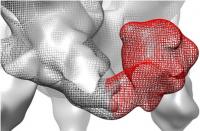
New techniques in electron microscope reveal new information about viruses, for example on the location of the variable V2 loop of HIV Env protein (red). This could give new insight... UC Davis researchers are getting a new look at the workings of HIV and other viruses thanks to new techniques in electron microscopy developed on campus.
The envelope (or Env) protein of HIV is a key target for vaccine makers: it is a key component in RV144, an experimental vaccine that is so far the only candidate to show promise in clinical trials. Also called gp120, the Env protein associates with another protein called gp41 and three gp120/gp41 units associate to form the final trimeric structure. The gp120 trimer is the machine that allows HIV to enter and attack host cells.
Professor R. Holland Cheng's laboratory at UC Davis has previously shown how the gp120 trimer can change its conformation like an opening flower. The new study, published in Nature Scientific Reports Nov. 14, shows that a variable loop, V2, is located at the bottom of the trimer where it helps to hold gp41 in place -- and not at the top of the structure, as previously thought.
"This challenges the existing dogma concerning the architecture of HIV Env immunogen," Cheng said.
Making a vaccine against HIV has always been difficult, at least partly because the proteins on the surface of the virus change so rapidly. Better understanding the structure of the gp120/Env trimer could help in finding less-variable areas of these proteins, not usually exposed to the immune system, which might be targets for a vaccine.
Understanding viral entry
A second pair of back-to-back papers from Cheng's lab uses new techniques in electron microscopy to probe how some common viruses hijack normal cellular processes to enter cells.
Cheng's lab has pioneered techniques in cryoelectron microscopy. Traditionally electron microscopy has relied on coating or impregnating samples with heavy metal elements. Cryoelectron microscopy uses extremely low temperatures to freeze biological structures in place instead.
By taking multiple images from slightly different angles and reconstructing them with computers, Cheng has been able to produce three-dimensional images of viruses and virus proteins and particularly, virus-infected cells.
However, because of the way electrons are scattered from samples, cryoelectron microscopes can only use a limited range of angles, creating a "missing wedge" in imaging infected cells. In one of the papers recently published in the journal PLOS ONE, Lassi Paavolainen and colleagues present a new statistical technique to reconstruct this missing data with no prior knowledge of the sample.
In the companion paper, Pan Soonsawad and colleagues applied the new technique to study the vesicles, or small bubbles that form inside cells when a picornavirus enters. The picornaviruses are a large group that includes the viruses that cause colds, gut infections, polio, hepatitis A and the recent outbreaks of contagious hand-foot-mouth disease (HFMD) spread in infants and children of younger age in U.S. this summer.
Picornaviruses get into cells by getting themselves dragged into an endosome, or pouched-off bubble from the cell's surface inside the cell. Then they exit the endosome and replicate their genetic material, RNA, in the cytoplasm of the host cells.
The new work shows that the endosomes are lined with host proteins called integrins, which are found in cell membranes. When integrins come close together in a membrane, they send signals into the cell. Viruses take advantage of this behavior, Cheng said. Attaching itself to a cell, the virus gathers integrins towards itself, triggering formation of an endosome.
"This virus collects integrins into a pattern so it can be 'swallowed' by the host cells," Cheng said.
Once inside, the new images show the endosomes breaking up as the viruses release their genetic material into the cell, leading to massive virus replication.
Despite the illness they cause, Cheng finds the viruses have their own charm.
"The virus is beautiful, because it has its own geometry that can be reused and redesigned for the benefit of human being," he said.
Indeed, Cheng's laboratory has patented technology that makes use of self-assembling proteins from the coat of Hepatitis E virus, including using them to deliver drugs or vaccines or to target breast cancer.
Source : University of California - Davis
 Print Article
Print Article Mail to a Friend
Mail to a Friend
